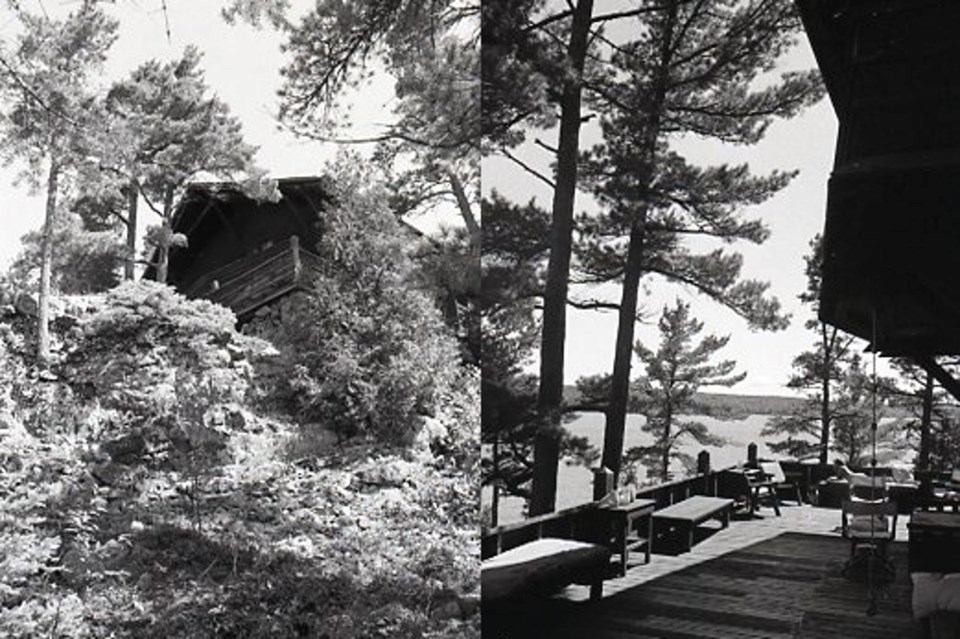If you have ever been brave enough to dare to jump off Whiskey Rock, you were close to a little-known landmark on nearby Sapper Island – the E.H. Pitkin Summer Lodge in Desbarats. Many are unaware, but this summer residence was designed by one of the most famous architects in North America – Frank Lloyd Wright and is the only specimen of his work still surviving in Canada.
The fact that this structure is even in existence is mere happenstance. Had it not been for an ad in a Chicago train station that tempted a friend of E.H. Pitkin to suggest a trip to the area, it would never have come to fruition.
According to Hermon Dunlop Smith in his book, The Desbarats Country, an acquaintance of the Pitkin family wrote to the Richard’s Landing Post Office in 1899 and was informed that the Rain’s Hotel on St. Joseph Island would be a great destination, with comfortable rooms and enjoyable activities such as fishing, golfing, and cycling. The reality when they arrived was a bit different – the hotel was just a farmhouse, the golf course just a field with a couple of holes, and bicycling was a chore on the corduroy roads. Nevertheless, the Pitkins and their friends had a great time.
One fateful day, they boarded a boat to explore the nearby islands.
Despite a downpour and generally wretched weather, the Pitkins were dazzled by the beauty and knew it would be spectacular in perfect weather. Who wouldn’t be?
Navigating amongst the islands provides a labyrinth of beautiful scenery – the contrast between the turquoise waters and the rocky shores with the lushness of the trees is a slice of paradise.
Only a few days later they purchased Sapper Island and asked their neighbour from Oak Park to design their cottage. That neighbour was Frank Lloyd Wright.
Wright, at the time, was just starting out. He had not yet developed his trademark “Prairie School” style for which he became well known and which is still influencing architects and home design to this day.
Yet, this early example of his work contains many touches that were emblematic of Wright. One example is the cabin’s split flue fireplace. There is a large central hearth with a flue that splits and runs to the outside of the building, which then allows for a central hallway on the second floor.
Secondly, the cabin boasts a large, wide-open living space, of which Wright was very fond. The cabin is also the embodiment of his desire for “organic architecture” in that the structure blends harmoniously with the natural habitat.
So, how has this, the only Frank Lloyd Wright structure in Canada remained such an enigma? Other Wright structures such as his masterpiece called Fallingwater, near Pittsburgh, have been open to the public for tours. UNESCO even designated eight of his designs as World Heritage sites.
The E.H. Pitkin cottage has somehow eluded this notoriety, with many locals unaware of its existence. This may in part be due to its somewhat remote location, which is only accessible by boat.
Also, the owners may be loath to draw too much attention to the place because many American Wright homes have been bestowed a landmark designation. With this designation comes a certain degree of status, but also limitations which could make it harder to make changes or repairs to a dwelling. These stipulations are often to ensure the integrity of the design endures.
There may also have been periods during the cottage’s history when its association with Frank Lloyd Wright may have been less flattering. Although he is well regarded now, he was often considered controversial during his lifetime. Wright received quite a bit of negative publicity about his personal life.
At one point, his relationship with the wife of a former client (Mamah Cheney) created a scandal and limited his ability to find work. It was considered quite shocking at the time that they had both left their spouses and children and were living together unmarried.
Tragedy soon followed when Mamah Cheney and her visiting children were murdered by a servant at Wright’s home in Wisconsin called Taliesin.
While recovering from this catastrophe, wright was involved with another mistress which was, yet again, controversial. He was also beset with many financial problems and debt, and once spent a night in jail for violating the Mann Act which made it a felony to transport women across state lines for immoral purposes.
Despite the celebrity of its designer, the cabin perched on the rocks in a spot of unparalleled beauty has quietly withstood the tests of time.
The cottage was sold by the Pitkins in 1916 to James Heyworth and the property remained in the family for at least three generations.
The cottage may be of great interest to architectural aficionados but to the owners, it is their private oasis. According to Barbara Gordon, Executive Director of the Frank Lloyd Wright Building Conservancy, “It takes a special person to take on the stewardship of owning and maintaining a Wright home.”
Clearly, all of the owners who have preserved this cabin for more than a hundred years are the proper guardians to ensure it continues as our secluded piece of history.
